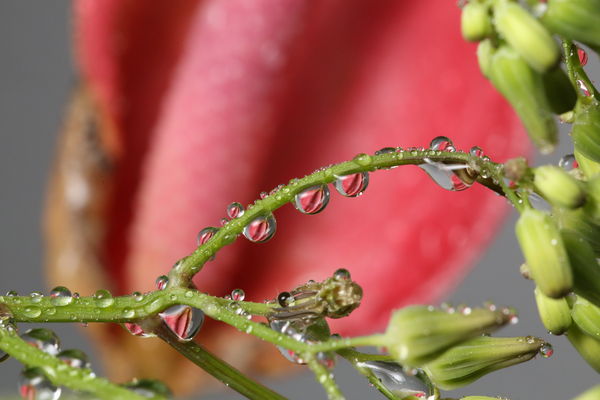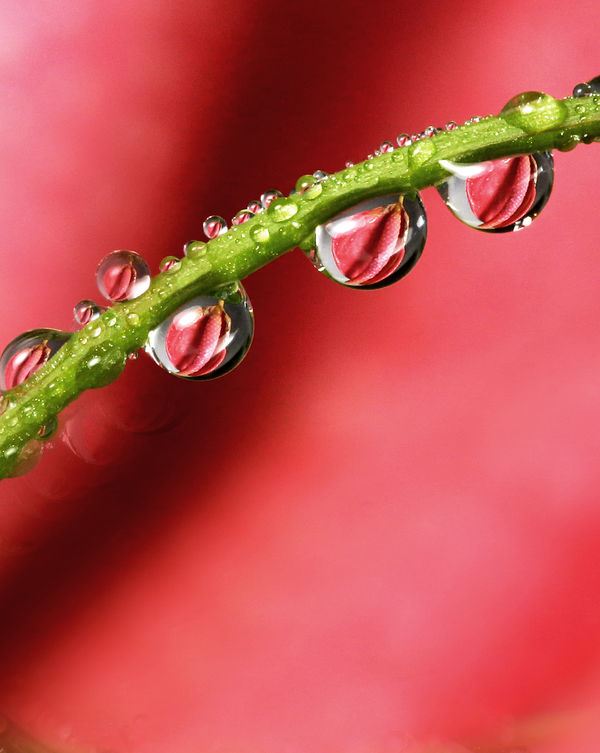Speedlight Power Settings for FF vs APS-C Macro Captures
Dec 31, 2014 10:55:31 #
This is a topic introduced on another thread but I thought that I would start a new one because I don't want to highjack the other with my images. As I stated in the other thread, with my Canon APS-C camera, I would not shoot macro above ISO 200. I typically shot at 100 to 160. I just got a new 6D and the ISO capabilities alone were worth the jump between the two formats. For macro, it allows me to shoot at much higher ISOs while reducing flash power which I think is a key factor in capturing crisp macro images, an added benefit of the reduced flash is the ability to shoot at slower shutter speeds while relying on the short flash duration to freeze motion. This allows for better capture of background blur instead of dark or black backgrounds, and it allows for almost immediate recycling of flash, not to mention crisp shots.
It is a wet messy day outside so I misted some plants inside so I could take a sample shot. I used the same setting as on the other thread, ISO 3200, 1/30-sec at f/14, speedlight power at 1/64th. I am quite happy with the result. I could never have done this on my APS-C Canon, as Canons don't seem to do as good of a job with high ISOs as do the Nikons, but Canon Full Frame, though still a bit less capable in high ISOs than the Nikons are still plenty capable as demonstrated here.
The first image is the shot straight out of camera, the second image is a cropped and processed version of the same.
It is a wet messy day outside so I misted some plants inside so I could take a sample shot. I used the same setting as on the other thread, ISO 3200, 1/30-sec at f/14, speedlight power at 1/64th. I am quite happy with the result. I could never have done this on my APS-C Canon, as Canons don't seem to do as good of a job with high ISOs as do the Nikons, but Canon Full Frame, though still a bit less capable in high ISOs than the Nikons are still plenty capable as demonstrated here.
The first image is the shot straight out of camera, the second image is a cropped and processed version of the same.
Dec 31, 2014 12:58:21 #
Blurryeyed, I also have the Canon 6D, which is an awesome low-light camera and I also have the T4i - a cropped camera. I usually use the T4i with my Canon 100mm macro lens to shoot subjects with plenty of available light and keep the ISO as low as possible. The crop T4i gives me a fuller frame of the subject, however, when I need a higher ISO, like with my MPE-65 - 1x to 5x lens, I always use the 6D. The 6D is hard to beat at higher ISOs which if shot with the T4i would be full of noise while the 6D's shots are great.
Dec 31, 2014 13:12:41 #
Moxie wrote:
Yes, I agree, maybe I should have been more clear in both the title of the thread and not having assumed that people would know what I was talking about in the quality of reduced flash settings. Here is an image of a computer fan with a black disk fastened to it with a solid white line, you can see that at flash settings higher than 1/16th the motion blur is evident, at full flash power it is actually really bad, by 1/32nd it is hardly visible and by 1/64th it is virtually gone. The point of the post is that using High ISOs which with Canon anyway you can only do with a full frame camera you can reduce your flash setting and rely on it to stop motion, these water drops were shot handheld at 1/30th at full 1:1 and we see no motion blur specifically because of the 1/64th flash setting. Another advantage is that instead of full flash, the low setting not only was able to freeze motion, but it served as fill flash allowing for the background to remain in the image, another advantage of using lower flash settings. Finally if you are into stacking or taking a lot of shots of your subject, if you have a good flash head your flash recharge will be pretty much instantaneous. Blurryeyed, I also have the Canon 6D, which is an ... (show quote)
The first image below illustrates the effectiveness of different flash settings on motion. The second image shot at 1/8000 with no flash illustrates just how ineffective shutter speed is on the same subject.
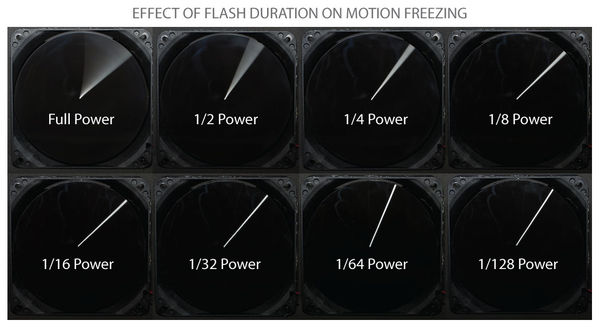
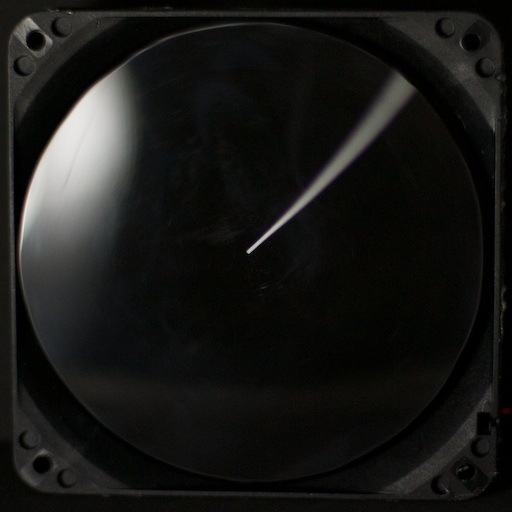
Dec 31, 2014 15:04:31 #
Holy Smokes big guy. I'm going to disagree with you on this specific capture. I think your ISO 3200 is to much as I can seen the remnants of noise in your finished processed photo. Maybe somewhere in the ISO 800 range would agree with my eyes more. I'm so use to using ISO 100 that just the hint of noise ruins the photo for Me. Granted, I love that your able to use the ambient light for better backgrounds/longer shutter speeds, and you have no motion blur/power setting on flash. But I'm looking for as clean a shot as possible and the noise doesn't cut it. As always, just my opinion.
Dec 31, 2014 16:07:25 #
fstop22 wrote:
I agree, but I still think that I can shoot between 800 and 1200. ISO 800 would be 2 full stops or power settings on the flash, 1200 would be 2.5. We will see, this was done just to illustrate the point that I was trying to make.Holy Smokes big guy. I'm going to disagree with yo... (show quote)
Dec 31, 2014 16:48:23 #
Blurryeyed wrote:
A Great Point, will try myself. This will help with doing water drops again as well, long time since I've tried them. Using the higher ISO and lower flash power will probably make it a game changer. ThanksI agree, but I still think that I can shoot between 800 and 1200. ISO 800 would be 2 full stops or power settings on the flash, 1200 would be 2.5. We will see, this was done just to illustrate the point that I was trying to make.
Dec 31, 2014 19:09:59 #
This is a beautiful subject with beautiful refractions and colours. I love it.
Jan 1, 2015 03:04:54 #
Geff, thanks for posting your results and illustration. The thought crossed my mind that some cameras seem to have less of a noise issue. I've only played with the 800e a little bit, but it seems to have less noise than the 7100. Between bumping up the ISO and a more powerful flash for shorter durations like the Nissin i866 that Douglass just got, I think we just might be able to have our cake and eat it too...at least to some extent :thumbup: I'm feeling cautiously optimistic :wink:
Jan 1, 2015 08:42:07 #
Blurryeyed wrote:
I've seen this fan demo before and don't understand how this relates to macro photography. Wouldn't the RPM of the fan affect the point at which a given flash power would "freeze" the line? Isn't the shutter duration also involved in the equation? The first image below illustrates the effectiveness of different flash settings on motion. The second image shot at 1/8000 with no flash illustrates just how ineffective shutter speed is on the same subject.
I'm still trying to understand the whole flash thing. I must be doing something very wrong. When I incrementally reduce flash power, I have to move my diffuser closer & closer until I bump into the subject. So your saying to crank up ISO instead of moving diffuser closer?
Jan 1, 2015 09:02:12 #
Thanks Brenda, Thanks Bill, Martin, I am eager to see you explore this a little bit, but honestly if your stuff gets any better it would have to somehow go 3D....
Jan 1, 2015 09:20:26 #
naturepics43 wrote:
Most flash illumination and flash power is a function of the duration of the light not the brightness of the light, the brightness is pretty consistent from full power down to 1/128th on the bigger flash units. The demonstration shows how ineffective shutter speed can be at stopping motion, when you compare the results of 1/64th flash power to the 1/8000th shutter speed there is no contest, the flash freezes the motion much more effectively. I've seen this fan demo before and don't understan... (show quote)
This is something that many people are unaware of and having used a full frame for the first time a couple of weeks ago I was amazed at the quality of high ISO performance and quickly related what that means for macro photography, higher ISO's directly equate to lower flash power settings, and since the flash so effectively freezes motion slower shutter speeds can be used which allows for more creativity in the background of your images.
I haven't been shooting much macro for the last year or so but I finally did break down and purchase a new macro lens for the new camera and so far I am liking this lens a lot, we will see what happens this spring, if I can get out and find some bugs.
Jan 1, 2015 09:40:58 #
Blurryeyed wrote:
Oh Boy, this Sounds like a challenge big guy?? Are you ready to play. Hope we can get a few of the guys and girls to jump in. 3D here we come.. . . if your stuff gets any better it would have to somehow go 3D.
Jan 1, 2015 16:17:35 #
Blurryeyed wrote:
This is EXACTLY why I recently purchased a Nissin Di866 speedlight, which is much more powerful than my Nikon SB-600 speedlight. I used to shoot macro at 1/4 to 1/2 power normally; now I shoot at 1/16 to 1/8 power as standard. Same amount of light, but much shorter duration, allows for better "stop action".Most flash illumination and flash power is a function of the duration of the light not the brightness of the light, the brightness is pretty consistent from full power down to 1/128th on the bigger flash units.
Speedlight power comparison
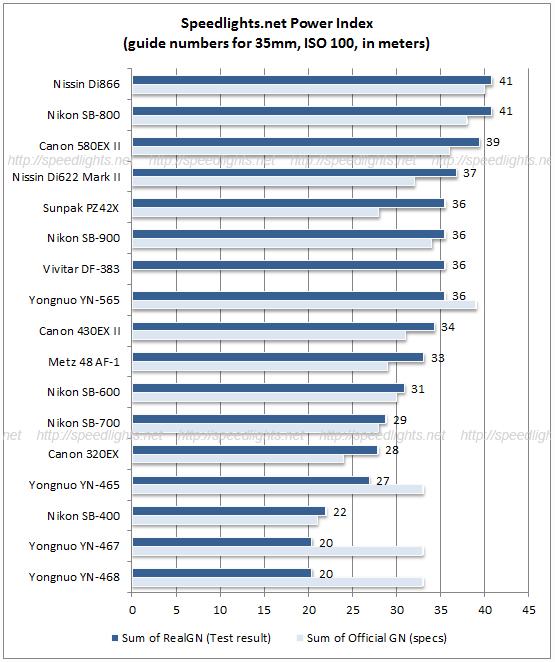
If you want to reply, then register here. Registration is free and your account is created instantly, so you can post right away.

